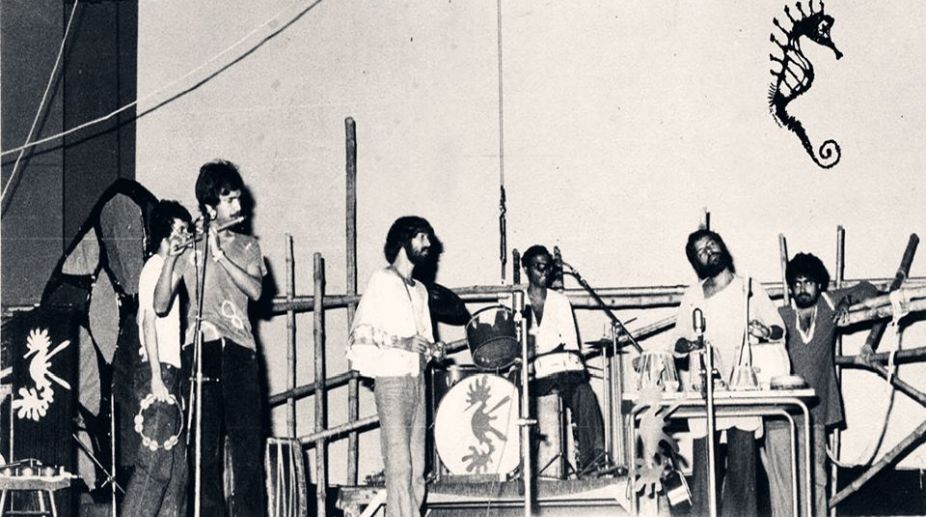Whatever runs faster than time, faces social barricades. The popular Bengali band Moheener Ghoraguli too had to deal with this fate.
The jolt of the Vietnam War was still existent, Naxal movement was at its peak–this was the juncture that, in 1975 and that year gave birth to the first ever Bengali band. The band was initially known as ‘Saptarshi’; but the proposal by Ranjon Ghosal to change it to ‘Moheener Ghoraguli’ became the decision.
Having Gautam Chattopadhyay as the leader, lyricist and vocalist, the band had other equally talented members such as Tapas Das on guitar and as vocalist, Abraham Majumder on piano and violin, Pradip Chatterjee at bass guitar and flute, Ranjon Ghosal, the emcee, visuals, media relations, Biswanath Chattopadhyay on drums and bass violin and Tapesh Bandopadhyay on guitar. However, in 1979, Tapesh left the band and was soon replaced by Raja Banerjee.
The initial albums of the band were Songbigno Pakhikul O Kolkata Bishoyok (1977), Ajaana Udonto Bostu ba Aw-Oo-Baw (1978) and Dreeshyomaan Moheener Ghoraguli (1979). Despite composing some spectacular music, Moheener Ghoraguli could not manage to win the hearts of the then orthodox Bengali listeners who preferred tracks from films.
Probably because of the fusion of baul, folk and jazz music that they composed, a whole new style, and which Bengalis listened to for the first time was not accepted well and they had to pay for being so iconoclastic. Even though the band had every element of uniqueness– in stage-decoration, in ticket-making (which at times looked just like a telegram or had the fingerprints of the band members), in the lyrics — the stubborn Bengali hearts refused to switch over to this music style they were use to listening to.
Nonetheless, Moheener Ghoraguli, through their robust ‘voice’ left a strong impact upon the youths which helped the band to win the hearts of the numerous people. In 1981, Subrata Ghosh, a zealous music lover and student of Presidency College, Kolkata, afetr listening the song “Bhalo Lagay Jyothsnay Kaash Boney Chhuttey” came to know about Gautam Chattopadhyay. Many new-generation music lovers who wanted a neoteric tide in Bengali music, gathered at the small drawing room of Monida’s house.
With the immense mental support of Subrata Ghosh and others, Gautam created a music revolution. In 1994, he was awarded with an assignment from Kolkata Doordarshan to make the first ever Bengali music-video. In 1995, the album Aabar Bochhor Kuri Porey (Again, 20 years later) was released at the Kolkata Book-fair.
This resuming journey was a gigantic hit indeed. However, the sad demise of Gautam Chattopadhyay, in 1999 finally put a stop to the band’sfurther proceeding. It took nearly 20-long-years for the people to realise the unparalleled potential of Moheener Ghoraguli. Since strong attachment with tradition has always been a typical character of Bengalis, it was normal for them to face hindrances in the way of wide social acceptance.
Still, the band became the pioneer of a new genre called Jeebonmukhi Gaan, which was later carried forward by Kabir Suman, Nachiketa, Anjan Dutt and others.
The lyrics of the songs of Moheener Ghoraguli are relevant even today. It is wonderful to notice how flour ishing the band, Moheener Ghoraguli, was in the decade of 1980s. They used the best Indian and even Western instruments to record music to make their creations the best in quality. The ones who were then unrecognised are now Bengal’s pride in music.
Some of their famous songs are Prithibita Naki…, Tomay Dilam, Telephone can still be found in the collection music lovers. Moheener Ghoraguli, through their incredible journey of music, left an indelible mark on the hearts of music lovers.
(Coordinator, Class XII, Belda Gangadhar Academy)










